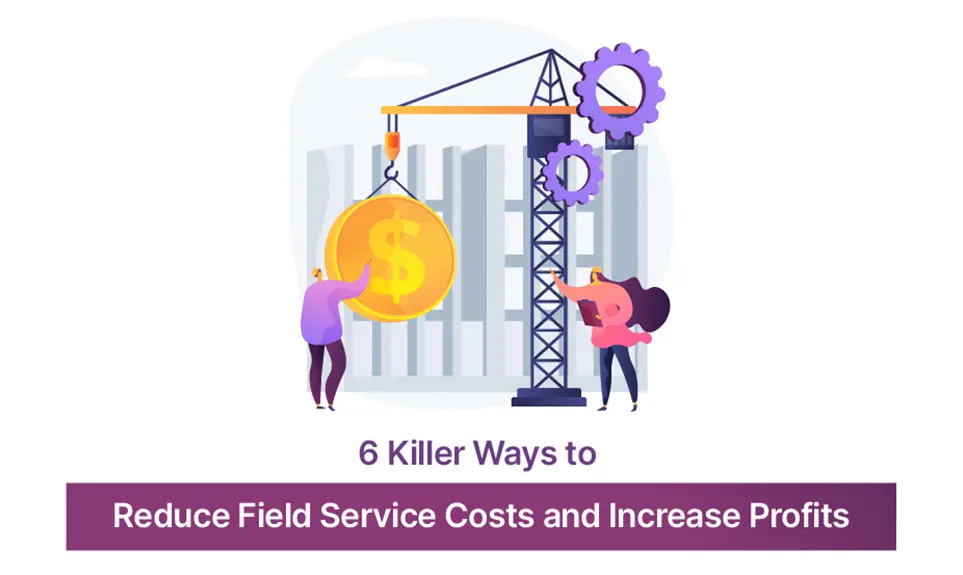In the field service industry, there’s a delicate balance between quality and cost. Delivering quality services comes at high operational costs. So, does it mean that field service companies should compromise on quality to reduce their costs? No. That cannot be the solution because quality-driven customers wouldn’t mind paying more for better services.
So, how can you strike the right balance? The first step is to look within your service delivery process. Figure out what part of the delivery process is eating into your profits. Use the information to optimize the service delivery process. That’s just the gist of it. Doing all these requires a surgical analysis of your cost-performance ratio.
Let’s understand this with the help of an example.
Assume that you spend most of your money on these crucial aspects of your business:Key AreasCost InvolvedPeople-Hiring-Training & development-Employee managementInfrastructure-Administrative cost-Overhead cost-Fixed assetsService delivery-Inventory-Knowledge management-Customer management-Travel
Evaluate the cost vs. performance ratio of each of these elements. Let’s try to evaluate the costs associated with travel.
The information which could lead you to the red flags in travel costs include:
- Number of schedules in a day (new as well as follow-up)
- Total travel expense in a day
- Number of issues resolved in a day
- Number of follow-up trips in a day
When you get this information in real-time, you can determine whether the problem is inefficient procedures or underpriced service portfolios.
If the number of resolved issues is less than the number of follow-up trips, it’s an efficiency issue.
If the number of resolved issues is higher than the number of follow-up trips, it’s a pricing issue.
Where,
Issues resolved = actual tasks done
Follow-up = technician’s visits to resolve an issue
Now that you get an idea of how to find out the performance vs. cost ratio, let’s discuss some techniques that have helped many field service organizations reduce their field service costs significantly.
1. Improve first-visit effectiveness
Suppose our follow-up trips are higher than the average number of issues resolved in a day, the problem could be with your first-visit effectiveness. For example, if your technicians take two trips to close each service call, then the situation is alarming. If one trip costs $20, and your technician makes four service calls in a day, the extra trips will cost $80 every day.
Potential causes of low first-time effectiveness include:
- Unavailability of tools and resources required to resolve the issue.
- Unplanned scheduling.
- Lack of customer information with the team.
How to tackle this issue:
- Know the issue and customer expectations in advance.
- Delegate the task to a rightfully skilled technician with the right tools to resolve the issue in the first attempt itself.
- Ensure that the task is completed to the satisfaction of the customer.
If these steps are followed, first-visit effectiveness will increase, and follow-up trips will decrease.
2. Optimize your scheduling
Poor scheduling can hurt the technician’s productivity and increase the field service operations cost. For example, if John has two work orders, one at 10 am and the other at 3 pm, and if he has to close four service requests in a day, his work has to be scheduled in a manner that:
- He gets a decent break in between trips.
- He has access to the right tools and customer information, including the location, in advance.
How to tackle this issue:
If the scheduling manager has the exact location details to track and monitor John’s activities, the schedule can be planned better.
Many field services companies use technology for scheduling. Field service scheduling software like Zuper can manage your entire scheduling and dispatching process. Here’s how it works:
- Tracks the location of field technicians in real-time.
- Matches skills with task type before assigning it to the rightly skilled technician.
- Assigns new tasks nearest to their location.
- Optimizes routes to save fuel costs.
Using Zuper, travel time can be reduced, costs incurred on traveling can be saved, and more jobs can be done in a day.
3. Automate your processes
According to a report, 52% of field service companies still use manual methods. These methods are not efficient or cost-effective.
How to tackle this issue:
If you have hired people to collect and report information, it’s time to make the switch to automated systems. Field service management technology can collect huge loads of information, including invoices, attendance, signatures, warranty, and contracts, etc.
This means your employees have more time to focus on efficiency and deliver an excellent customer experience. Efficient employees work more and cost less. Follow these steps to bring in automation:
- Assess your entire field service management lifecycle.
- Identify redundant/repetitive processes.
- Figure out the employee cost for managing those processes.
- Plan to automate those processes to save the associated costs.
4. Optimize inventory management
One study revealed that reducing stock-outs and overstocks can reduce the overall inventory management cost by 10%.
How to tackle this issue:
Evaluate the stock in hand and figure out how you can improve. Some questions to ask to help understand your current inventory situation are:
- Are stock-in and stock-out notifications sent in real-time?
- Does your team have access to inventory-related information?
- Can you keep track of outdated stock, current stock, frequently used tools, and hardly used tools?
With this information handy, you can easily optimize inventory management. If you don’t have this information, get hold of tools that can give you the real-time status of the inventory. Zuper’s inventory management software can help improve inventory management and your cash flow. With this tool, you can:
- Schedule a field service technician only when the right tools are available.
- Plan restocking based on urgent and future requirements.
- Reduce amount spent on non-essential inventory.
- Manage relationships with suppliers.
- Save on storage cost.
5. Get business information in real-time
Access to real-time information strengthens your decision-making capabilities. If you have the right information at the right time, you can bring an incremental change in the field service delivery processes that can essentially reduce field service operations costs.
How to tackle this issue:
Field service management software can provide you with data in real-time at your fingertips. Equipped with this information, you have a clear picture of what’s working for you and what’s not. You can then easily make changes to increase efficiency to generate more revenue with lower costs to increase your bottom line.
6. Save on hiring and training
In a competitive industry like field service, retaining your best talent is an effective method of saving money on hiring and training new employees. Your employees’ efforts must be recognized and rewarded to keep them motivated to deliver their best work every time.
How to tackle this issue:
Set performance metrics for your field service team by tracking the following parameters:
- Number of work orders assigned in a day.
- Number of calls made by the field service representative.
- Number of work orders completed in a day.
- Current status of the task assigned.
- Inspection and validation of the task.
Evaluate the technicians’ performance based on the above parameters and reward or compensate them on the metrics achieved.
Conclusion
These were some of the ways you can reduce costs and direct your cash flow to more automated, streamlined, and error-free processes.
Take the help of tools to complete the work orders, use mobile apps to keep your team connected at all times, keep information at your fingertips, and make more effective data-driven decisions.
Learn how Zuper can help you reduce field service delivery costs and overall field service operations costs. Start your free trial.



